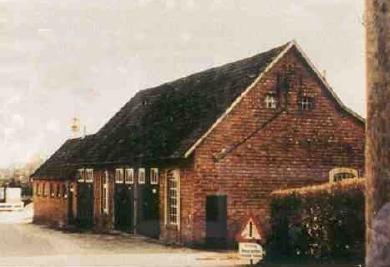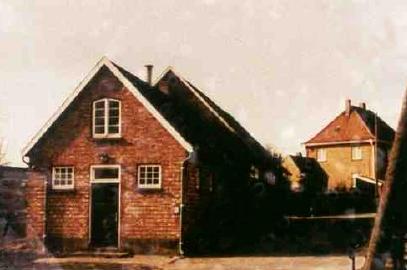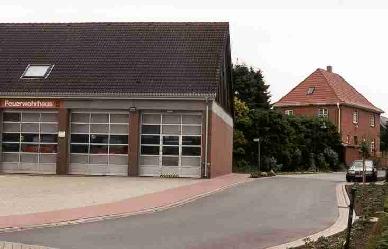|
|
|
|

Louis Hondebrink
Louis Hondebrink (age 92) reports
By Heinrich Baumann
Heinrich: "Louis, you have been getting old, you surely know something about the Zentrale!"
Louis: "You bet I know, pay attention and write it down in standard German, because a lot of the young people do not understand the Lower German dialect any more."
After Worldwar I, Georg Jacobs "behind the town hall" and the physician Dr Heinmüller were the driving forces who pushed Uelsen into getting electrical power. They founded the Electricity Cooperative eGmbH Uelsen. The first motor with a generator attached to it was located at the back of the houses, which are being inhabited by Würtz and Klünder today. This "power station" must have had too many teething troubles, because after a short operation time it was deinstalled and sold to the Netherlands.
Around 1919 or 1920 the "Zentrale" was built at the place where the fire brigade is located today. Anthracite coal has been heated up under sealed conditions in a so called gas generator. The smoulder gas reached two suction gas motors through pipes. The smaller motor had 25 HP (19 kW) and the bigger one had 40 HP (30 kW), though this was only the case when the gas had been mixed with the proper amount of air before ignition. The smaller motor had to be started by hand. For that, one person had to step into a spoke wheel, the other person had to turn the outer rim. It used to be not easy in cold winter nights. Once, Hermann Stiepel stood on the spokes and I was turning the rim when a pre-ignition suddenly swung the wheel backwards. Herman was slinged up. Fortunately I could cushion his fall and nothing happened to him in the end.

The bigger motor was water-cooled and was started by the use of compressed air. Big transmission belts carried the motor power onto generators (dynamos) which provided 220 Volts direct-current. Hermann Stiepel and Hans Pohlmann used to be the operation engineers. They took care that the machines were running from 5 am to 11 pm. In alternation one person was on duty from 5 am to 8 pm, the other person from 5 am to 6 pm and from 8 pm to 11 pm.
The nightly energy demand was coverd by batteries that had been charged during the day. Several rows of glass receptables, each of 1/2 m x 1/2 m x 3/4 m in size and equipped with battery plates, were standing in a side room.
The fire was on "low flame" during the night. On sundays and holidays only the smaller motor with the little dynamo was running. On the fair days with shooting competition of the rifle association, I used to have the supreme command of the Zentrale. Pohlmann and Stiepel were both members of the musician division. Hans played the flute and Hermann drummed.
The service area of the Uelsen Zentrale extended from Lübbermann and Siemelink (Vischer/Weerd) at Lemke, who had a separate power line to the Zentrale, to the houses of the customs officers at the Getelo Road. For the line to the custom's houses, Hans Pohlmann and me had to install an A-pole at Bokenkämpken. We had great difficulties with that. The pole was too heavy for two men.
The workshops, which had been turned from manual working to machine working (Furniture dealer Voet, Beck-Geit, carriage maker Scholten and others) were the main electricity consumers. When at nightfall the lighting in the houses was turned on, the voltage dropped down to 180 Volt. If you take in account an additional voltage drop due to the length of the power lines, say up to the houses at Getelo Road, you can imagine that the light bulbs were not more than red glow lights. Anyhow, there were "light bulbs" of only 10 to 15 Watts for the halls and some of 20, at the most 25 Watts for the living- and working rooms.
For that, a road lighting had to be abandoned. The few kerosene lamps on head-high poles in the town center were still giving their sparse light. Gerrit Mülder took his small ladder every evening, he went from lamp to lamp and held a match stick at them.

Public Bath
In 1927 Uelsen got a public bath facility with 3 tubes and 4 showers. The bath was attached directly to the Zentrale. I used to be the stoker during the whole operation time (nearly 30 years) and I got my home there later. After World War II, when the homes were about to get their own bath facilities, the public bath had to be taken out of order.
In the very beginning, the water for the public path was taken from the
Massbecke creek. From 1929, after Uelsen got a central water supply, the
water was taken from there. The boiler held water for 3 bath tubes. The
central heating was connected to the boiler as well. During winter time
it became sensitively cold when several bathers took their bath. This
changed when a modern 1000 litre boiler was purchased. The cozy warmth
turned my dwelling place into a meeting place for some Uelsen guys after
work. That's why Timmer's Ope, Beckmann's Hermann and Kip-Herme met here
for a skat often.

The door to the Zentrale was then left open, because Stiepel and Pohlmann wanted to listen to the "talkies". But they couldn't join in, they had to monitor the control panel in order to bring the air- and gas supply in line with the unsteady voltage. At 9 pm Timmer's Ope had to leave for a short time. He had to ring the bells. The ringing mechanism was already electrically powered by the Zentrale. With the exception of the normal inspections the "Zentrale" had been running without malfunction. In the year 1931 the NIKE took over the supply of electrical power.
"That's that, now you have to get it right in German!".
This story is quoted with kind permission of Heinrich Baumann. It originates from the book "850 Jahre Uelsen", published by the municipality Uelsen in 1981.
|
|
|
Created: Aug 04, 2001, last modification: Jul 11,
2005 |